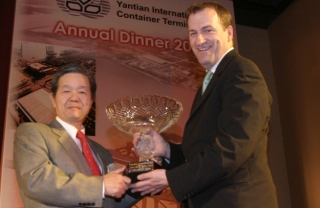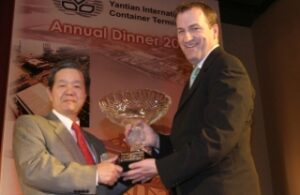
YICT
Best in Class
Lorem ipsum dolor sit amet, consectetur adipiscing elit. Ut elit tellus, luctus nec ullamcorper mattis, pulvinar dapibus leo.

YICT GLOBAL BEST IN CLASS CONTAINER TERMINAL
After researching how container terminals across the world compared with YICT it became evident that they had first mover advantage and as such were identified as the benchmark in container terminal operation globally. This led to accreditation of YICT as the the Worlds “Best in Class” Container Terminal by the Institute. In recognising YICT, the Institute is underlying the importance of the continuing and expanding co-operation between end users and container terminal operators to make the port centric logistics process more efficient.
The evolutions in supply chains and logistics models urge container terminal operators to re-think their function in the logistics process. Terminals are central to the design of supply chains and are considered as strategic assets.
The Institute’s research program The Role of Container Terminal Operation in Global Logistics focuses on how Container Terminal Operators are responding to this new opportunity and responsibility.
Findings from the Institutes research program “U.S. Beneficial Cargo Owners Sourcing in China: The Logistics Challenges” identified that “Best in Class” international logistics departments supporting procurement departments sourcing intercontinentally, demand direct relationships with each stakeholder in the logistics process.
The majority of Fortune 500 companies outsource directly to third party logistics provider’s (3PL’s) however it is regarded as “best practice” to have direct contact with the the key logistics service providers, particularly the liner shipping company and the container terminal operator.
Home Depot who the Institute has accredited as “Best In Class” in the execution Of Container Logistics Strategy pioneered direct relationships with container terminal operators. It was through this research that we became aware of Yantian International Container Terminals (YICT) and its ground breaking work.
YICT is the world’s largest single container terminal and are champions of “Joined Up Thinking” and have built their cargo volumes through marketing directly to cargo-owners a strategy they called ‘End User Marketing’.
YICT END USER MARKETING STRATEGY
YICT is regarded as the first container terminal operator to deploy an End User Marketing strategy. The driver for this is that Beneficial Cargo Owners (BCO’s) do not have contractual relationship with any of stakeholders inside the port, leading to a dependence on third parties for status reports etc. This can lead to misreporting and guessing about the status of a particular container. This is mitigated by container terminal operators liaising directly with BCO’s and their 3PL’s.
BCO’s report that direct relationships with container terminal operators has led directly to greater Visibility, increased Velocity and added Value add in their container logistics processes. For terminal operators direct relationships with their end user had a direct influence on decisions by shipping lines to include their terminal on their network maps. Shipping lines are heavily influenced by their upstream customers − the port’s end users.
The YICT approach to collaboration has also lead to logistics innovation particularly in the area of “Port Centric Logistics” which again the terminal is credited with innovating.
Port Centric Logistics which as we know has grown to become a vital part of global supply chain strategy today was born in Shenzhen out of this dynamic and continues to proliferate globally, DP World’s $2.5 Billion Dollar development London Gateway in the U.K. is built on a port centric model.
After researching how container terminals across the world compared with YICT it became evident that they had first mover advantage and as such were identified as the benchmark in container terminal operation globally. This led to accreditation of YICT as the the Worlds “Best in Class” Container Terminal by the Institute.
In recognising YICT, the Institute is underlying the importance of the continuing and expanding co-operation between end users and container terminal operators to make the port centric logistics process more efficient.
The philosophy behind YICT and its attitude towards its operations is that it is part of the logistics process, where there must be due regard for both the inbound and outbound mechanisms that surround port movement. The Institute believes that this innovative approach, the port paying due respect to the smooth operation of the supply chain, should be mirrored across the globe.
THE RESEARCH FINDINGS FROM THE YICT RESEARCH PROGRAM
In 1993, Yantian International Container Terminals Limited was formed as a joint venture between the Shenzhen Municipal Government and the international consortium headed by the Hong Kong based Hutchison Whampoa Group. The contract was signed on 5 October, 1993 in Beijing. YICT’s charter was to develop and operate the Yantian port to become an international container terminal, catering to the needs of international shipping lines.
Administratively, from the Shenzhen government perspective, port development was the responsibility of a quasi-government business group known as Dong Peng Industry Company Limited, which later in January 1995 changed its name to the Yantian Port Group. Typical of special economic developments of the time, the company was given little money but freedom and policy flexibilities to explore non traditional ways of port development. The Dong Peng Industry Company/Yantian Port Group was Hutchinson’s direct partner in the YICT joint venture.
What has happened over the last 22 years at Yantian is nothing short of an economic miracle and the Institute’s research clearly identifies that this success was achieved by pioneering innovations built on its legal and strategic framework.
MODULE 1: Legal and Strategic Framework
YICT is an equity joint venture between Hutchison Port Holdings (HPH) and Yantian Port Group (YPG), a subsidiary of the Shenzhen city government. This ownership structure between a private company and government body became the key reason for the success of YICT and indeed Shenzhen port.
MODULE 2 :YICT A Public Private Partnership
The success of the partnership became evident In November 1995 when YICT was formally appointed by the Beijing government as the ‘pilot site’ for national port administration reforms. This was a major breakthrough in legitimizing YICT’s aim to develop a ‘world-class port’ and opened up a wider program of port reform in China as a whole.
MODULE 3: An Agenda For Reform
In the course of a few years, the YICT team developed an agenda for reform in government agency port practice, ranging from simplification of procedures to innovative applications of computer technology.
MODULE 4: Two Key Innovations
Careful examination of the first three years of YICT’s existence shows how the business model was developed.The pillars were End User Marketing and Port Centric Logistics
Conclusions
YICT proved port operators who succeed in adding value play an important role in the supply chains of global shippers (buyers and manufacturers) — a role that ports traditionally found themselves excluded from.
In bestowing the Institutes inaugural ‘Global Best in Class Container Terminal” accreditation on YICT, we have identified the benchmark port in global containerization. Since its inception in 1994, YICT has set itself apart by approaching its task differently.
YICT, as a result of its enormous responsibility to provide a quality service that supports China’s emergence as the world’s leading trading nation and also because of competition from other port operators in the region, adopted a very open flexible approach.
YICT collaborates with its End Users, to provide a competitive, efficient solution. It continuously invests in next generation technology and materials handling in anticipation rather than in reaction to market changes. The terminals management and executives have become available to the global logistics community in a way not witnessed before and have done much to herald in a new dawn in the history of port operator/shipper relations. Port operators worldwide need to look to Yantian when choosing the operation to emulate.
IF IT CAN’T BE MEASURED, IT CAN’T BE MANAGED
YICT introduced Six Sigma which they in turn leveraged to develop their own Terminal Quality System built around Benchmarks, KPI’s and ‘measure to manage’ methodologies. The results were very impressive. The management team at the terminal had identified the key processes in their operation and, by recording their performance daily, were able to build up a picture of the terminals operational performance pattern and set goals around continuous improvement targets.
No amount of infrastructural development could have kept pace with throughput at YICT, in the year 2001-2002 it experienced a 52% increase. To meet this demand YICT had to achieve almost double the industry average of efficiency per berth (1.2 million TEUs. The industry average is 700,000). Its monthly productivity average was 35 moves per hour per quay crane and in some cases achieved 59 moves per hour per crane using a single lift method.
While truck turnaround time in some of the world’s major ports stretches to two or three hours, Yantian had a rate of 41.7 minutes in 2003, which was cut to 37.4 minutes in 2004 and then again to 36.5 minutes in 2005 with an average of about 10,000 trucks coming onto the site every day.
YICT had won the business, now they were determined to keep it. Above all they did not want to make the mistake of over-trading which could lead to bottlenecks and congestion and the destruction of their hard won reputation. Testament to this was YICT’s investment in the latest equipment and technology, and its maintenance of active links with business schools, consultants, and firms leading in management practice.
An example of the latter was YICT’s direct approach to General Electric and Motorola to access details of the Six Sigma system which they leveraged to develop their own Terminal Quality System built around Benchmarks, KPI’s and ‘measure to manage’ methodologies. The results were very impressive. The management team at the terminal had identified the key processes in their operation and, by recording their performance daily, were able to build up a picture of the terminals operational performance pattern and set goals around continuous improvement targets. Moreover it helped to identify the most efficient operatives who were encouraged by incentives to share their insights and techniques with other team members.
The system gave enormous comfort to shipping lines and BCO’s who were reassured by YICT’s approach. In many cases details and results of the system were openly shared with all stakeholders which only served to reinforce their value and application.
Beneficial Cargo Owners like Home Depot, only too aware that US west coast container throughput capacity was in danger of falling up to 10 million TEU short of anticipated demand by 2008, were keen to use YICT’s formula to conduct their own research on US west coast container terminals and help them to decide on carrier contracts based, not just on the port of call, but also on the terminal of call.
This approach to Quality management became the inspiration for the Container Terminal Quality System (CTQS) subsequently developed by the Institute in partnership with DNV GL
YICT: A VERY OPEN FLEXIBLE APPROACH
In bestowing the Institutes inaugural ‘Global Best in Class Container Terminal” accreditation on YICT, we have identified the benchmark port in global containerization. Since its inception in 1994, YICT has set itself apart by approaching its task differently. YICT, as a result of its enormous responsibility to provide a quality service that supports China’s emergence as the world’s leading trading nation and also because of competition from other port operators in the region, adopted a very open flexible approach.
Velocity is the hallmark of effective logistics. The global supply chain is as strong as its weakest link and as fast as its slowest one. Much like a relay race the effectiveness of the process is all about the handover or interchange between the athletes in the team or in the case of logistics the modes of transport employed. If executed correctly and diligently no speed is lost in the hand over, however if the receiving team member is not alive to the imminent transaction and constantly in a state of expectancy the process breaks down and worse, continues through to the next relay in the race.
Logisticians have traditionally seen the port piece in the global supply chain equation as the weakest link or if you like the team member cast as the poor receiver/ deliverer. Ports have long enjoyed the enviable position of being indispensable in the creation of and execution of international and global supply chains and as such tended to set the transport agenda in their space as opposed to accommodating it. If the global logistics revolution was to succeed then a new modern type of port had to emerge, our objective was to identify and accredit it.
In bestowing the Institutes inaugural ‘Global Best in Class Container Terminal” accreditation on YICT, we have identified the benchmark port in global containerization. Since its inception in 1994, YICT has set itself apart by approaching its task differently. YICT, as a result of its enormous responsibility to provide a quality service that supports China’s emergence as the world’s leading trading nation and also because of competition from other port operators in the region, adopted a very open flexible approach.
YICT collaborates with its End Users, to provide a competitive, efficient solution. It continuously invests in next generation technology and materials handling in anticipation rather than in reaction to market changes. The terminals management and executives have become available to the global logistics community in a way not witnessed before and have done much to herald in a new dawn in the history of port operator/shipper relations. Port operators worldwide need to look to Yantian when choosing the operation to emulate.
THE STORY OF YANTIAN INTERNATIONAL CONTAINER TERMINALS
YICT is a joint venture established by Hutchison Port Holdings and the Shenzhen Yantian Port Group. The JV commenced operations in mid-1994. The Company is responsible for operating and managing the first 3 Phases of Yantian Port, where it has nine container berths. Total investment now reaches HK$ 13.8 billion. The past eleven years have seen exponential growth at the port in large part due to the rapid expansion of the Chinese economy.
The natural deepwater Port at Yantian has led to it attracting the major international shipping line. There are currently 74 weekly shipping services calling at Yantian, which include 41 US bound and 22 bound for Europe, making it one of the busiest ports in Southern China.
The port is surrounded by a sophisticated road network, which ensures the smooth flow of cargo between the port and the manufacturing bases. It also enables Yantian to have frequent and accessible contact with southern China. As a result of the rapid development of Yantian Port and Eastern Shenzhen, YICT has co-operated with the municipal and district governments, traffic management and planning departments on several initiatives which have included both financial support and material resources to upgrade the local road network. As part of continuing infrastructure development in the area 7 major road improvement projects are due for completion in 2007.
Pingyan Railway, which starts at Yantian in the south, is a dedicated railway with a total length of 23 kilometres. It provides YICT with distribution, consolidation and multi-modal transportation services.
YICT is continually striving to minimise bureaucracy and recently signed a memorandum of understanding with Shenzhen Entry-Exit Inspection and Quarantine Bureau to increase inspection and quarantine efficiency.
These improvements to business procedures and increased speed with cargo declarations have enabled customers to save time and money. The continued strive to innovate and respond to customers’ requirements in both managements and operations are all contributing to the standard that has Yantian in a ‘class of its own’. As a demonstration of its own efficiency Yantian holds the world record for Container Movements.
Press Release
SHENZHEN MARCH 2005
YANTIAN INTERNATIONAL CONTAINER TERMINALS “BEST IN CLASS”
Following an ongoing and detailed research study into how container terminal operators can influence logistics provision the Institute is recognizing the work of Yantian International Container Terminals (YICT), a division of Hutchison Port Holdings as the Global leader in container terminal operation.
The announcement comes as a result of the Institute’s ongoing analysis of the efficiency with which container terminals are operated. The research has been targeted at revealing which container terminal most readily integrates themselves into a seamless supply chain and continually search for efficiencies in the logistics process. The research sought to identify the container terminals, which set the standards of excellence in the way terminals are operated.
In recognising YICT, the Institute is underlying the importance of the continuing and expanding co-operation between port end users and container terminal operators to make the process more efficient. Time consuming bureaucracy and inefficiency can have no part in the global supply chain.
The philosophy behind YICT and its attitude towards its operations is that it is part of the logistics process, where there must be due regard for both the inbound and outbound mechanisms that surround port movement. The Institute believes that this innovative approach, the container terminal is paying due respect to the smooth operation of the supply chain, should be mirrored across the globe.
Speaking at the announcement of the award, Mr. Kenneth Tse, Director and General Manager of YICT said:
“I’m very honoured to accept this award on behalf of Yantian International Container Terminals. It shows that YICT’s past efforts have been well recognised by industry’s leaders – carriers, end users and logistics experts. In today’s global economy, international businesses are seeking further opportunities in sourcing globally. To survive, YICT has to be an integral part of the supply chain. We must support the logistics community to stay competitive”
The ‘Spirit of YICT’ is such that both its management and operations staff have a commitment to finding further efficiencies on a daily basis.
YICT is a joint venture established by Hutchison Port Holdings and the Shenzhen Yantian Port Group. The JV commenced operations in mid-1994. The Company is responsible for operating and managing the first 3 Phases of Yantian Port, where it has nine container berths. Total investment now reaches HK$ 13.8 billion. The past eleven years have seen exponential growth at the port in large part due to the rapid expansion of the Chinese economy.
The natural deepwater Port at Yantian has led to it attracting the major international shipping line. There are currently 74 weekly shipping services calling at Yantian, which include 41 US bound and 22 bound for Europe, making it one of the busiest ports in Southern China.
The port is surrounded by a sophisticated road network, which ensures the smooth flow of cargo between the container terminal and the manufacturing bases. It also enables Yantian to have frequent and accessible contact with southern China. As a result of the rapid development of Yantian Port and Eastern Shenzhen, YICT has co-operated with the municipal and district governments, traffic management and planning departments on several initiatives which have included both financial support and material resources to upgrade the local road network. As part of continuing infrastructure development in the area 7 major road improvement projects are due for completion in 2007.
Pingyan Railway, which starts at Yantian in the south, is a dedicated railway with a total length of 23 kilometres. It provides YICT with distribution, consolidation and multi-modal transportation services.
The port company is continually striving to minimise bureaucracy and recently signed a memorandum of understanding with Shenzhen Entry-Exit Inspection and Quarantine Bureau to increase inspection and quarantine efficiency. These improvements to business procedures and increased speed with cargo declarations have enabled customers to save time and money. The continued strive to innovate and respond to customers’ requirements in both managements and operations are all contributing to the standard that has Yantian in a ‘class of its own’. As a demonstration of its own efficiency Yantian holds the world record for Container Movements.
Commenting on the award Kieran Ring, CEO of the Global Institute of Logistics said:
“Velocity is the hallmark of effective logistics. The global supply chain is as strong as its weakest link and as fast as its slowest one. Much like a relay race the effectiveness of the process is all about the handover or interchange between the athletes in the team or in the case of logistics the modes of transport employed. If executed correctly and diligently no speed is lost in the hand over, however if the receiving team member is not alive to the imminent transaction and constantly in a state of expectancy the process breaks down and worse, continues through to the next relay in the race.
Logisticians have traditionally seen the port piece in the global supply chain equation as the weakest link or if you like the team member cast as the poor receiver/ deliverer. Ports have long enjoyed the enviable position of being indispensable in the creation of and execution of international and global supply chains and as such tended to set the transport agenda in their space as opposed to accommodating it. If the global logistics revolution was to succeed then a new modern type of port had to emerge, our objective was to identify and accredit it.
In bestowing the Institutes inaugural ‘Best Global Container Port of the Year 2005-06” accreditation on YICT, we are confident that we have identified the benchmark port in global containerization. Since its inception in 1994, YICT has set itself apart by approaching its task differently. YICT, as a result of its enormous responsibility to provide a quality service that supports China’s emergence as the world’s leading trading nation and also because of competition from other port operators in the region, adopted a very open flexible approach.
Right from the outset YICT made efforts to understand and reach out to those businesses that would use their port, working with what it clearly views as its partners, to provide a competitive, efficient solution for its clients. In an effort to communicate this enthusiasm YICT has invested in next generation technology and materials handling in anticipation rather than in reaction to market changes. As we all know putting your money where your mouth is, is still the greatest talking that any organization can do.
YICT’s management and executives have become available to the global logistics community in a way that we haven’t witnessed before and have done much to herald in a new dawn in the history of port operator/shipper relations, We are delighted to honor them in this way and encourage port operators worldwide to look no further than Yantian when choosing the operation to emulate.
I would like, on behalf of the Institute’s council and members, to congratulate all at the port on this wonderful achievement and to encourage them to continue to innovate, they have the global third party logistics industry’s support.”
NOTES TO EDITORS
ABOUT GLOBAL INSTITUTE OF LOGISTICS
The Global Institute of Logistics (GIL) was established in 2003 under the Chairmanship of renowned US logistician and author Robert V. Delaney in response to the logistics industry’s call for “joined up thinking” amongst stakeholders in the global supply chain. GIL looks to resolve the challenges facing the global logistics chain of managing single transport modes, modal systems and targets which are set on stand-alone operations to create a seamless global logistics system.
A Think Tank, GIL brings together thought-leaders and thought-followers as part of a global knowledge network committed to building up the information base, best practices and standards. This, in turn, creates a platform through which knowledge is shared, best practice is adopted and trade developed. Today the Institute is a community of organizations and professionals from across the world that share a commitment to collaborating on global logistics solutions.
The Institute’s mission is to ‘Network the Global Logistics Community’
For further information, visit www.globeinst.org

